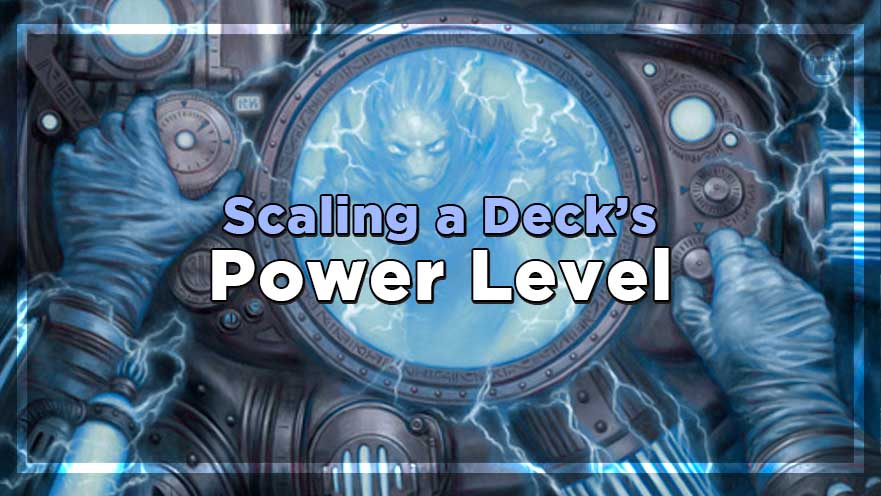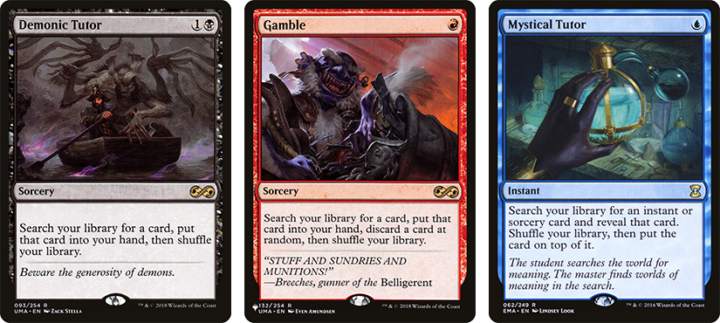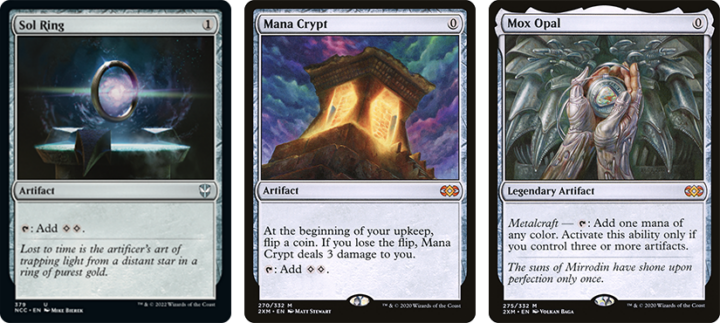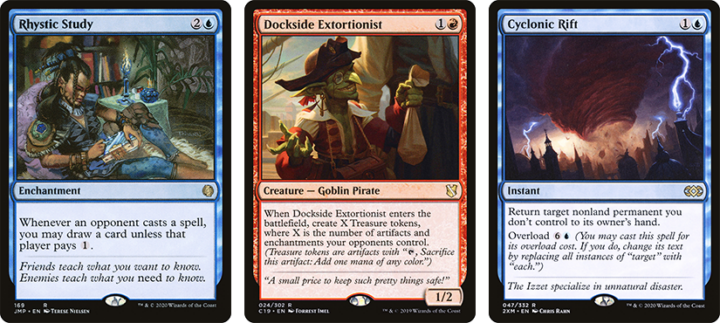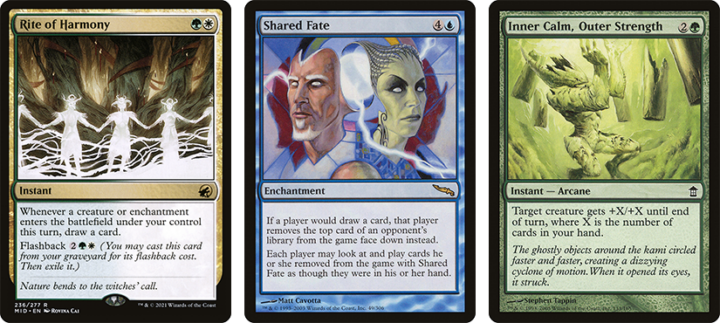Scaling an EDH deck’s power level to a given table can be tricky, but Scott’s here to give you some helpful advice about how to do it!
Power level in Commander has always been a hot button topic, and it’s only becoming more pressing as time goes on. The prevalence of treasures and built-for-Commander legendary creatures inches the power level status quo higher with every set, and the release of dedicated Commander sets like Commander Legends: Battle for Baldur’s Gate is always a volatile time for casual tables.
While I don’t believe that any of these individual cards or concepts are inherently problematic, they do require active attention and consideration when deciding on a deck’s power level. They’re certainly not the only things to take into account, either; there are a number of ways that you can adjust a deck to suit your table or the kind of games you play, which is exactly what I’m going to cover today.
Power Levels
Before I talk about the different considerations for power level, you need to know exactly what kind of power level you’re aiming for. “Casual” isn’t much of a descriptor, and a number on a scale of one to ten is devoid of almost all useful information (plus, every deck is described as a seven). Many power levels have been given labels for easier identification, like Nitro Casual, Artisan, cEDH, or even Precon. These are more strictly defined power levels that are fairly comprehensive, though they aren’t always going to suit the style of play you might want. If you’re looking to figure out or define a new power level that you want to play at, my recent article on codifying power levels in Commander might be exactly what you need.
It’s also important to note that this isn’t a call for players to depower their decks. I love higher power as much as the next mage, but it’s not the only level that people like to play at. Having access to multiple different power levels means that you’ll have the tools available to contribute to a fun and balanced environment, which will result in a more varied and enriching experience.
Power Level Considerations
The way I see power level is less of a numeric scale, and more of a spectrum. A deck’s positioning in this space can be tweaked and altered based on two main axes: speed, and consistency. There are a number of different ways that you can adjust along these lines, and most of them are able to be broken down into card categories.
Tutors
Tutors are cards that search for specific cards in your deck. They are usually synonymous with higher power levels, due to the increased level of consistency they afford you. If you’re looking to increase power level, you can add a few tutors to help find your key pieces; similarly, you can replace tutors with card draw if you’re looking to depower a deck.

Some examples of tutors that can be used to add flexibility over power.
It’s important to note that not all tutors will have the same impact on a deck’s power level. Demonic Tutor, for example, is much more potent than Trinket Mage. I run Trinket Mage in my Tameshi, Reality Architect deck as a way to search for interaction or mana, like Tormod’s Crypt or Darksteel Citadel, but it can’t be used to fetch combo pieces. This is a great example where a tutor can be used for additional flexibility to help you cope with problems more reliably, without moving the needle too much into another power level.
Fast Mana
Fast mana is generally considered to be any form of mana production that makes more mana than it costs to cast. Sol Ring, Mana Crypt, and Mox Opal, would all be considered fast mana. Even temporary boosts, like Dockside Extortionist, Dark Ritual, or Jeska’s Will would be considered fast mana; they may not be a permanent boost, but they give you enough of a head start to pull ahead of anyone else that doesn’t have the same fast draw.
One of the easiest ways to supercharge a deck is to load it up with fast mana, but it can be used responsibly at lower power levels too, specifically the temporary boosts. Seething Song is regularly used in lower powered red decks for example, as it lets you get a threat out sooner; these effects become significantly more problematic if you try to abuse it however, like with Dockside Extortionist loops.

a few great mana rocks to replace fast mana at lower power levels.
If you want to reduce the speed of a deck, swapping fast mana out for regular mana rocks is ideal (see my article on 3 mana rocks for inspiration), or even adding more lands might be the right call. Be sure to check your deck’s mana curve and costs to make sure you can still consistently cast your spells with whatever you add!
Mana Base
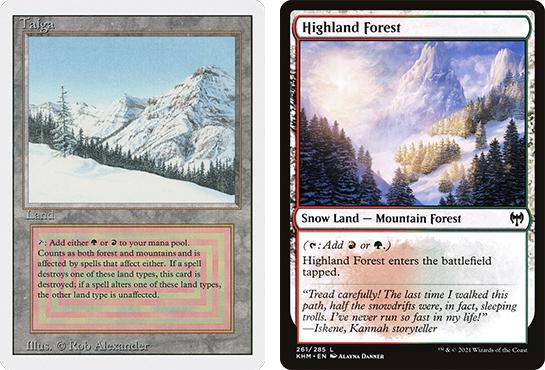
These are not the same.
A perfect mana base removes a lot of the resource management and planning for the game. While this generally has less of an impact than the likes of tutors or fast mana, it can increase both speed and consistency. If you have a perfect fetch land/dual land mana base, you’re virtually guaranteed to be able to cast your spells on time and on curve in every game. This kind of mana base can show up at lower power levels, but it’s usually reserved for more powerful decks. The difference between a deck with a perfect mana base, and a preconstructed deck right out of the box is night and day; keep this in mind when you’re adjusting a deck’s power level.
Interaction
The higher the power level, the more likely you are to need removal for a problematic permanent or engage in a counter war; this is due to the increased threat density and sheer potency of most decks at the higher tiers. Lower power levels generally don’t need as much interaction; sometimes this is down to a lower overall threat level, but many relaxed pods are also happy to let each other do their thing for a bit before stepping in.
One trick that I use with my budget decks to help increase their power level, is to add more interaction. This generally helps to keep up with some stronger tables, but doesn’t stop it from fitting in just fine with lower power pods. This isn’t so much of a power level adjustment, but rather adapting your deck to be able to contain or stop issues as they arise.
Redundancy
Redundancy is including several cards that all have similar effects to increase your deck’s consistency. This is somewhat similar to tutors, but it can actually be more dangerous in terms of threat level. If a player tutors for a combo piece, but you remove it before they can win, then it’s usually no longer a threat. With additional redundancy in the deck, they could just topdeck another combo enabler and threaten to win again. This strains the interaction of other players more than tutors do, which is a great thing to do at higher levels, but more casual tables would struggle to have fun in such a situation.
Reconsider Those Staples
Do you really need the Rhystic Study? Are you just adding Dockside Extortionist without a good reason? Is there a more interesting or synergistic option available? If so, you should try it out! Not only will it often be more fun to play with, but it could help settle the power level of a deck. If you’re looking to reduce a deck’s power level, you could reduce it by replacing these staples with more suitable options. Take my Octavia, Living Thesis deck for example: I could have run Cyclonic Rift, but instead I chose Whelming Wave. It only bounces creatures and can only be cast at sorcery speed, but it’s much more thematic. It’s also less irritating for the table, since it doesn’t completely undo most of the development in the current game.
Replacing staples with more synergistic or flavorful options is a little more difficult to adjust to power level, as the results can vary. Some changes may feel like a lateral move, whereas some will wildly alter the strength of the deck.
Mindset
This is definitely the most nebulous aspect, but also one that can have the biggest impact. Your approach to piloting a specific deck is going to wildly alter the power level that you’re bringing to the game.
When you sit down to play, you should be making sure that the mindset you’re bringing to the table is appropriate for the game you’re about to have. If you go into a relaxed game with the idea that you must play optimally at all points, you’re probably going to make the game miserable for someone else. Similarly, if you go into a high powered or cEDH game with no real aim to play well, you’re likely to upset the rest of the table (and probably not enjoy it yourself).
Mindset is generally what I use as a smoothing mechanic. I use the previous considerations to build an appropriately powered deck, and to choose the right one for any given game; I then alter my in-game approach to fine-tune the experience for the table. If it feels like my deck is a little too strong, I’ll rein it back a little; if I feel like it’s not quite up to snuff, I’ll start to play much more optimally to ensure the game stays balanced.
If you want a little more about mindset, my piece about intent in Commander is all about the approach to each game, and how it affects the experience for everyone involved.
Powerboard
If you love your deck as it is, but you feel it’s not quite the right power level, you don’t necessarily have to change the deck entirely. You could consider a powerboard: a 10-20 card sideboard that replaces that many cards in the deck to change it to a different power level. This way, you can have two completely different experiences in the one deck. You could even have an additional power level if you wanted: the first ten cards of the powerboard adjust the deck up to a certain power level, while adding the rest of the powerboard will increase it a bit more again!
Playtest, Playtest, Playtest
Regularly reviewing your deck’s performance is paramount to ensuring you keep your decks at the power level that you want. When it comes to nailing a particular power level for a deck, there is simply no substitute for playtesting; it’s the single best way to find any issues that need addressing.
You won’t find every issue immediately, especially considering most decks only see a portion of the ninety-nine in any given game. You may need to playtest and adjust a deck over the course of several games to get it to a level that you’re happy with. It’s also not unheard of for decks to continue to change over time; sometimes decks will slowly drop in power compared to the rest of the table, or a playgroup’s power levels may drift. Being cognizant of this keeps you in control of the experience you’re bringing to the table, and maximizes the number of great games you’ll have.
Adjusting to power level is certainly one of the more advanced aspects of Commander, as it takes into account much more than just the cards themselves. It also requires efficient and effective pregame conversations, as without them the power levels don’t mean much. As with most aspects of this social format, communication is key!
These are some of the key power considerations that I take into account when I build and edit decks. I hope this helps you to determine and adjust to the power level that you like to play, and hopefully it will result in better games.

Scott is an Irish content creator and the Head of Budget Magic for the Izzet League. He focuses on affordable decks in Pioneer, Modern, and Pauper, particularly ones that stray from the mainstream. When he’s not writing about his favorite decks, he can be found talking incessantly about them on Twitter and on The Budget Magic Cast.

